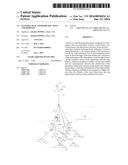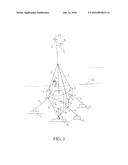Patent application title: FLOATING DUAL ANEMOMETER - MAST AND DOPPLER
Inventors:
Antonios Peppas (Athens, GR)
IPC8 Class: AG01P502FI
USPC Class:
73195
Class name: Measuring and testing volume or rate of flow system
Publication date: 2016-01-21
Patent application number: 20160018434
Abstract:
A device of a dual floating anemometer comprised of a mast, support arms
for instruments, purlins, a central buoy, connecting beams, the edge
floaters, the buoy hoop, the buoy--anchorage connector, anchorage hoop,
anchorage, wind measuring instruments A, the connector beam of the
anemometer base B, the wind instrument base B wind measuring instruments
B, the anchorages of the edge floaters, the connections of the anchorages
of the edge floaters with the edge floaters and the connector hoops of
the anchorages with the edge floaters, which can be placed in shallow or
big water depths and can simultaneously measure the characteristic wind
parameters using both common anemometers and Doppler anemometers, so that
the measurements of the wind potential (velocity, direction, turbulence)
are extended to a higher altitude than the altitude of the mast which
bears the cup anemometers, because of the combinatorial action.Claims:
1. A device of a dual floating anemometer comprised of a mast (1),
support arms for instruments (2), purlins (3), a central buoy (4),
connecting beams (5), the edge floaters (6), the buoy hoop (7), the
buoy--anchorage connector (8), anchorage hoop (9), anchorage (10), wind
measuring instruments A (11), the connector beam of the anemometer base B
(12), the wind instrument base B (13) wind measuring instruments B (14),
the anchorages of the edge floaters (15), the connections of the
anchorages of the edge floaters with the edge floaters (16) and the
connector hoops of the anchorages with the edge floaters (17),
characterized in that the device can be placed in shallow or big water
depths and can simultaneously measure the characteristic wind parameters
using both common anemometers and Doppler anemometers, so that the
measurements of the wind potential (velocity, direction, turbulence) are
extended to a higher altitude than the altitude of the mast which bears
the cup anemometers, because of the combinatorial action.
2. A device of a dual floating anemometer according to claim 1 characterized in that the central floater (4) and the edge floaters (6) are located under the water surface.
3. A device of a dual floating anemometer according to claim 1 characterized in that the wind measuring instruments A are cup anemometers (11) and the Doppler wind measuring instruments B are LiDAR or SODAR (14).
Description:
TECHNICAL FIELD
[0001] The invention refers to a floating meteorological station suitable for wind measurements at significant reference heights in the open sea, by simultaneous application of conventional mast anemometer (cup anemometer) and Doppler anemometer.
STATE OF THE ART
[0002] Devices which measure data of the wind, such as velocity and direction, and are placed on fixed or rotating bases on land or anchored to the bottom of the sea are known. These devices are not able to measure the velocity of the wind in the case that their base is moving or oscillating the way floating bases do. There are also floating devices for the measuring mainly of meteorological variables mounted on devices for the measuring of the waving. These devices do not measure the data of the wind at an altitude over 5 to 10 m from sea level and do not provide wind measurement data adequate for wind resource assessment of Offshore Wind Parks.
[0003] The device according to the present invention remedies this serious drawback by providing bankable wind data.
DESCRIPTION OF THE INVENTION
[0004] The advantage of the present invention is its ability to measure the velocity of the wind at high altitudes from the sea level in areas of shallow water and also in areas having a big depth from the average sea level. In this way, useful wind data concerning the dimensioning and the wind potential of floating wind generators can be acquired.
[0005] Furthermore, the combination of mast and Doppler technology, (e.g. LiDAR) provides the possibility of correlation between LiDAR and mast anemometer data. The construction buoyancy provides excellent stability and optimal reliability for the wind measuring due to minimizing the angular velocity of the mast (1) and of the instrument base B (13) which bears the instruments. The decrease of the angular velocities is very important, because the data from the anemometers do not need to be corrected, or the correction is minimal. Under normal operating conditions, the angular moves of the construction regarding the vertical axis are minimal; this makes the measuring corrections of the Doppler instruments unnecessary.
[0006] The floating anemometer according to attached FIG. 1 comprises: a mast (1), support arms for instruments (2), purlins (3), a central buoy (4), connecting beams (5), edge floaters (6), a buoy hoop (7), a buoy--anchorage connector (8), an anchorage hoop (9) an anchorage of the floater (10), wind measuring instruments A (11), the connector beam of the anemometer base B (12), the wind instrument base B (13), the wind measuring instruments B (14), the anchorages of the edge floaters (15), the connections of the anchorages of the edge floaters with the edge floaters (16) and the connector hoops of the anchorages with the edge floaters (17).
[0007] The wind measuring instruments (11) are attached to the support arms (2), which in turn are attached to the mast (1). The mast (1) bears the loads (measurings instruments and own weight) and transfers them to its support base (4), as well as through the purlins (3) to the edge floaters (6). The purlins (3) are mounted on the edge floaters (6) and operate as a resistance to the bending forces of the mast (1) resulting in a lighter construction of the mast (1). The floaters, both the central (4) as well as the edge floaters (6) are connected to each other by the beams (5) and operate as an integrated floating construction, which repositions the mast to the upright position. These connecting beams (5) are equal in number to the edge floaters and each of them can either be independent or have purlins mounted to the central floater (4). The floaters (central and edge floaters) are completely immersed and lighter than the water to exert a buoyancy force to the whole construction. The balancing of the construction is achieved by the restoring torque, because of the buoyancy of the edge floaters (6). Thus the construction returns faster to the vertical axis (original situation), which results in a limited movement of the anemometer and a better measuring. The rotational movement is limited by the anchorage of the edge floaters. The immersed part of the construction is in a level, where it remains unaffected by the waves on the sea surface (18).
[0008] The combination of the geometrical data of: the floaters (4) & (6), the mast (1), the purlins (3), the beams (5), the anchorage (10) and (15), the connections of floaters--anchorages (9 and 17), the freeboard constructions, and the construction materials and their weights determines the normal frequency of the floating construction. This normal frequency may vary depending on the design in the location of mounting the device, i.e. the characteristics of the waves and of the wind. The edge floaters (6) can be three or more according to the floating construction's needs.
[0009] The central buoy (4) and the edge floaters (6) have on their lower part a buoy hoop (7), onto which the buoy anchorage-connector (8) is tied, which may consist entirely or partly of a chain, a rope, a wire rope or any other suitable material and can be single or double for greater safety. This connection essentially connects the floating construction with an anchorage hoop (9) and finally with an anchorage (10) which on one hand prevents the moving of the floating construction beyond a certain limit, and on the other hand counterbalances the buoyancy forces of the construction. This anchorage lies at the bottom of the sea. The remaining anchors (15) are connected in the same manner with the edge floaters (6) and prevent the construction from rotating around a vertical axis.
[0010] The parts (1), (2), (3) and (5), (12) and (13) can be made of metal (e.g. steel, aluminum) or synthetic materials (plastic, carbon fibers). The parts of the floaters (4) and (6) can be made of metal, synthetic materials, concrete or any other suitable material, either hollow or solid. To assure their floating ability, they can be filled with light materials such as wood, expanded polyurethane, cork, expanded polystyrene, etc. The parts (7), (9) and (17) are made of metal, the parts (8) and (16) can be made of different appropriate materials either entirely or partly and the parts (10) and (15) can be made of any other suitable material (concrete, metal, etc.).
[0011] The measuring instruments A, see (11) FIG. 1, can be of any suitable form and are using any suitable technology for measuring the velocity and the direction of the wind; the measuring instruments B, see (15) FIG. 1, can be measuring instruments for the velocity and the direction of the wind which are using Doppler technology (LiDAR or SODAR) and measuring instruments for the solar radiation, for the humidity, for the temperature, photovoltaic cells, measuring instruments for the level, devices for the transmission of information, as well as any other suitable measuring instrument.
[0012] This device enables the measurement of wind data, such as wind force and wind direction at a high altitude from the level of the sea and at great depths. The placement of other meteorological instruments is also possible, either on the central floater or on the mast, or on the support arms for instruments or on the base of the measuring instruments B. This device provides excellent stability under extreme weather and sea conditions and provides simultaneous use of conventional wind measuring technology, like cup anemometer and remote sensing technology such as LiDAR and SODAR. This enables the calibration and the correlation between different wind measuring instruments. The floating dual anemometer can also operate as a mast anemometer or as a Doppler measuring instrument without a mast.
User Contributions:
Comment about this patent or add new information about this topic:


